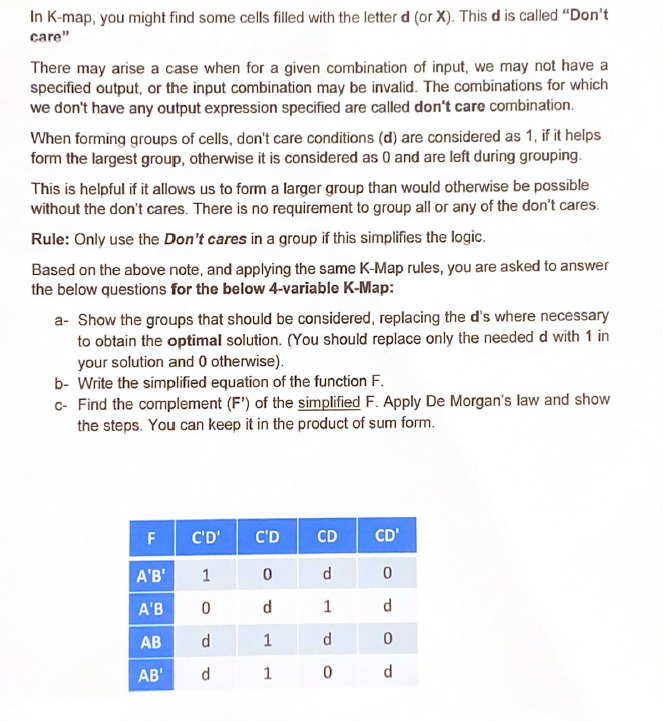In K-map, you might find some cells filled with the letter d (or X). This d is called "Don't care" There may arise a case when for a given combination of input, we may not have a specified output, or the input combination may be invalid. The combinations for which we don't have any output expression specified are called don't care combination. When forming groups of cells, don't care conditions (d) are considered as 1, if it helps form the largest group, otherwise it is considered as 0 and are left during grouping. This is helpful if it allows us to form a larger group than would otherwise be possible without the don't cares. There is no requirement to group all or any of the don't cares. Rule: Only use the Don't cares in a group if this simplifies the logic. Based on the above note, and applying the same K-Map rules, you are asked to answer the below questions for the below 4-variable K-Map: a- Show the groups that should be considered, replacing the d's where necessary to obtain the optimal solution. (You should replace only the needed d with 1 in your solution and 0 otherwise). b- Write the simplified equation of the function F. c- Find the complement (F') of the simplified F. Apply De Morgan's law and show the steps. You can keep it in the product of sum form.
In K-map, you might find some cells filled with the letter d (or X). This d is called "Don't care" There may arise a case when for a given combination of input, we may not have a specified output, or the input combination may be invalid. The combinations for which we don't have any output expression specified are called don't care combination. When forming groups of cells, don't care conditions (d) are considered as 1, if it helps form the largest group, otherwise it is considered as 0 and are left during grouping. This is helpful if it allows us to form a larger group than would otherwise be possible without the don't cares. There is no requirement to group all or any of the don't cares. Rule: Only use the Don't cares in a group if this simplifies the logic. Based on the above note, and applying the same K-Map rules, you are asked to answer the below questions for the below 4-variable K-Map: a- Show the groups that should be considered, replacing the d's where necessary to obtain the optimal solution. (You should replace only the needed d with 1 in your solution and 0 otherwise). b- Write the simplified equation of the function F. c- Find the complement (F') of the simplified F. Apply De Morgan's law and show the steps. You can keep it in the product of sum form.
Introductory Circuit Analysis (13th Edition)
13th Edition
ISBN:9780133923605
Author:Robert L. Boylestad
Publisher:Robert L. Boylestad
Chapter1: Introduction
Section: Chapter Questions
Problem 1P: Visit your local library (at school or home) and describe the extent to which it provides literature...
Related questions
Question

Transcribed Image Text:In K-map, you might find some cells filled with the letter d (or X). This d is called "Don't
care"
There may arise a case when for a given combination of input, we may not have a
specified output, or the input combination may be invalid. The combinations for which
we don't have any output expression specified are called don't care combination.
When forming groups of cells, don't care conditions (d) are considered as 1, if it helps
form the largest group, otherwise it is considered as 0 and are left during grouping.
This is helpful if it allows us to form a larger group than would otherwise be possible
without the don't cares. There is no requirement to group all or any of the don't cares.
Rule: Only use the Don't cares in a group if this simplifies the logic.
Based on the above note, and applying the same K-Map rules, you are asked to answer
the below questions for the below 4-variable K-Map:
a- Show the groups that should be considered, replacing the d's where necessary
to obtain the optimal solution. (You should replace only the needed d with 1 in
your solution and 0 otherwise).
b- Write the simplified equation of the function F.
c- Find the complement (F') of the simplified F. Apply De Morgan's law and show
the steps. You can keep it in the product of sum form.
F
A'B'
A'B
AB
AB'
C'D'
1
0
d
d
C'D
0
d
1
1
CD
d
1
d
0
CD'
0
d
0
d
Expert Solution
This question has been solved!
Explore an expertly crafted, step-by-step solution for a thorough understanding of key concepts.
Step by step
Solved in 4 steps with 4 images

Knowledge Booster
Learn more about
Need a deep-dive on the concept behind this application? Look no further. Learn more about this topic, electrical-engineering and related others by exploring similar questions and additional content below.Recommended textbooks for you

Introductory Circuit Analysis (13th Edition)
Electrical Engineering
ISBN:
9780133923605
Author:
Robert L. Boylestad
Publisher:
PEARSON

Delmar's Standard Textbook Of Electricity
Electrical Engineering
ISBN:
9781337900348
Author:
Stephen L. Herman
Publisher:
Cengage Learning

Programmable Logic Controllers
Electrical Engineering
ISBN:
9780073373843
Author:
Frank D. Petruzella
Publisher:
McGraw-Hill Education

Introductory Circuit Analysis (13th Edition)
Electrical Engineering
ISBN:
9780133923605
Author:
Robert L. Boylestad
Publisher:
PEARSON

Delmar's Standard Textbook Of Electricity
Electrical Engineering
ISBN:
9781337900348
Author:
Stephen L. Herman
Publisher:
Cengage Learning

Programmable Logic Controllers
Electrical Engineering
ISBN:
9780073373843
Author:
Frank D. Petruzella
Publisher:
McGraw-Hill Education

Fundamentals of Electric Circuits
Electrical Engineering
ISBN:
9780078028229
Author:
Charles K Alexander, Matthew Sadiku
Publisher:
McGraw-Hill Education

Electric Circuits. (11th Edition)
Electrical Engineering
ISBN:
9780134746968
Author:
James W. Nilsson, Susan Riedel
Publisher:
PEARSON

Engineering Electromagnetics
Electrical Engineering
ISBN:
9780078028151
Author:
Hayt, William H. (william Hart), Jr, BUCK, John A.
Publisher:
Mcgraw-hill Education,